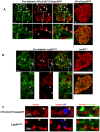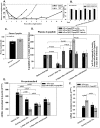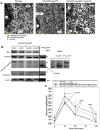Insulin therapy for pre-hyperglycemic beta-cell endoplasmic reticulum crowding
- PMID: 23408938
- PMCID: PMC3567120
- DOI: 10.1371/journal.pone.0054351
Insulin therapy for pre-hyperglycemic beta-cell endoplasmic reticulum crowding
Abstract
Insulin therapy improves β-cell function in early stages of diabetes by mechanisms that may exceed alleviation of glucotoxicity. In advance type 2 diabetes, hyperglycemia causes β-cell damage and ultimately β-cell loss. At such an advanced stage, therapeutic modalities are often inadequate. Growing evidence indicates that in early stages of type-2 diabetes and some types of monogenic diabetes linked with malfunctioning endoplasmic-reticulum (ER), the β-cell ER fails to process sufficient proinsulin once it becomes overloaded. These changes manifest with ER distention (ER-crowding) and deficiency of secretory granules. We hypothesize that insulin therapy may improves β-cell function by alleviating ER-crowding. To support this hypothesis, we investigated pre-diabetic β-cell changes in hProC(A7)Y-CpepGFP transgenic mice that develop prolonged pre-diabetes due to proinsulin dysmaturation and ER-crowding. We attenuated the β-cell ER proinsulin synthesis with a treat-to-target insulin therapy while avoiding hypoglycemia and weight gain. Alleviation of ER-crowding resulted in temporary improvement in proinsulin maturation, insulin secretion and glucose tolerance. Our observations suggest that alleviation of pre-diabetic ER-crowding using a treat-to-target insulin therapy may improve β-cell function and may prevent further metabolic deterioration.
Conflict of interest statement
Figures



Similar articles
-
Misfolded proinsulin in the endoplasmic reticulum during development of beta cell failure in diabetes.Ann N Y Acad Sci. 2018 Apr;1418(1):5-19. doi: 10.1111/nyas.13531. Epub 2018 Jan 28. Ann N Y Acad Sci. 2018. PMID: 29377149 Free PMC article. Review.
-
In vivo misfolding of proinsulin below the threshold of frank diabetes.Diabetes. 2011 Aug;60(8):2092-101. doi: 10.2337/db10-1671. Epub 2011 Jun 15. Diabetes. 2011. PMID: 21677281 Free PMC article.
-
Asna1/TRC40 Controls β-Cell Function and Endoplasmic Reticulum Homeostasis by Ensuring Retrograde Transport.Diabetes. 2016 Jan;65(1):110-9. doi: 10.2337/db15-0699. Epub 2015 Oct 5. Diabetes. 2016. PMID: 26438609
-
The endoplasmic reticulum in pancreatic beta cells of type 2 diabetes patients.Diabetologia. 2007 Dec;50(12):2486-94. doi: 10.1007/s00125-007-0816-8. Epub 2007 Sep 30. Diabetologia. 2007. PMID: 17906960
-
Dietary toxins, endoplasmic reticulum (ER) stress and diabetes.Curr Diabetes Rev. 2008 May;4(2):146-56. doi: 10.2174/157339908784220697. Curr Diabetes Rev. 2008. PMID: 18473761 Review.
Cited by
-
Insulin gene mutations and posttranslational and translocation defects: associations with diabetes.Endocrine. 2020 Dec;70(3):488-497. doi: 10.1007/s12020-020-02413-2. Epub 2020 Jul 12. Endocrine. 2020. PMID: 32656694
-
Endoplasmic Reticulum Stress and Obesity.Adv Exp Med Biol. 2024;1460:373-390. doi: 10.1007/978-3-031-63657-8_13. Adv Exp Med Biol. 2024. PMID: 39287859 Review.
-
Misfolded proinsulin in the endoplasmic reticulum during development of beta cell failure in diabetes.Ann N Y Acad Sci. 2018 Apr;1418(1):5-19. doi: 10.1111/nyas.13531. Epub 2018 Jan 28. Ann N Y Acad Sci. 2018. PMID: 29377149 Free PMC article. Review.
-
Structural Lessons From the Mutant Proinsulin Syndrome.Front Endocrinol (Lausanne). 2021 Sep 30;12:754693. doi: 10.3389/fendo.2021.754693. eCollection 2021. Front Endocrinol (Lausanne). 2021. PMID: 34659132 Free PMC article. Review.
-
Diabetes associated with dominant insulin gene mutations: outcome of 24-month, sensor-augmented insulin pump treatment.Acta Diabetol. 2016 Jun;53(3):499-501. doi: 10.1007/s00592-015-0793-1. Epub 2015 Aug 4. Acta Diabetol. 2016. PMID: 26239141 Free PMC article. No abstract available.
References
-
- Li Y, Xu W, Liao Z, Yao B, Chen X, et al. (2004) Induction of long-term glycemic control in newly diagnosed type 2 diabetic patients is associated with improvement of beta-cell function. Diabetes Care 27: 2597–2602. - PubMed
-
- Ryan EA, Imes S, Wallace C (2004) Short-term intensive insulin therapy in newly diagnosed type 2 diabetes. Diabetes Care 27: 1028–1032. - PubMed
-
- Alvarsson M, Sundkvist G, Lager I, Henricsson M, Berntorp K, et al. (2003) Beneficial effects of insulin versus sulphonylurea on insulin secretion and metabolic control in recently diagnosed type 2 diabetic patients. Diabetes Care 26: 2231–2237. - PubMed
-
- Weng J, Li Y, Xu W, Shi L, Zhang Q, et al. (2008) Effect of intensive insulin therapy on beta-cell function and glycaemic control in patients with newly diagnosed type 2 diabetes: a multicentre randomised parallel-group trial. Lancet 371: 1753–1760. - PubMed
Publication types
MeSH terms
Substances
Grants and funding
LinkOut - more resources
Full Text Sources
Other Literature Sources
Medical
Molecular Biology Databases

